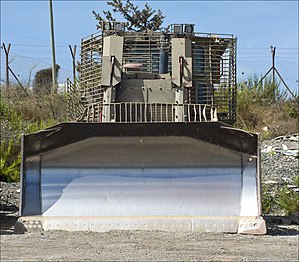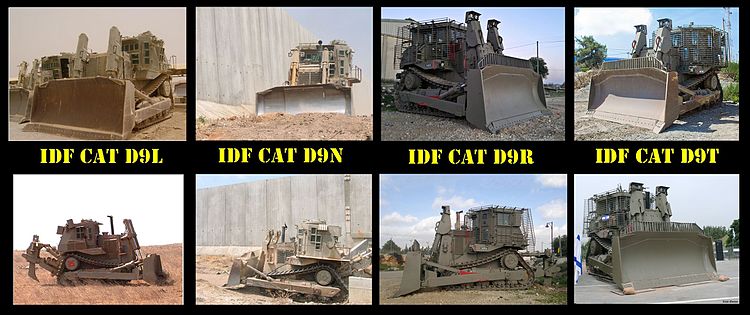| Revision as of 07:26, 24 November 2015 view source203.40.88.217 (talk) not requiredTags: Mobile edit Mobile app edit← Previous edit | Revision as of 14:40, 24 November 2015 view source TracyMcClark (talk | contribs)Extended confirmed users, Pending changes reviewers15,852 editsm Reverted 1 edit by 203.40.88.217 (talk) to last revision by Aaron Brenneman. (TW)Next edit → | ||
| Line 64: | Line 64: | ||
| *] | *] | ||
| *], head of the ], killed in the ] by an IDF D9 | *], head of the ], killed in the ] by an IDF D9 | ||
| * ], an ] activist killed by an IDF D9 while acting as a ] | |||
| ==References== | ==References== | ||
Revision as of 14:40, 24 November 2015

The Israeli Armored CAT D9—nicknamed Doobi (Template:Lang-he, for teddy bear)—is a Caterpillar D9 armored bulldozer that was modified by the Israel Defense Forces, Israeli Military Industries and Israel Aerospace Industries to increase the survivability of the bulldozer in hostile environments and enable it to withstand heavy attacks, thus making it suitable for military combat engineering use. The IDF Caterpillar D9 is operated by the Israel Defense Forces (IDF) Combat Engineering Corps for combat engineering and counter-terrorism operations.
Characteristics

The D9R, the latest generation of Caterpillar D9 bulldozers in IDF service, has a power of 405–410 horse power and drawbar pull of 71.6 metric tons (about 716 kN). Older generations, such as D9L and D9N are still in service, mainly in the reserve forces. The D9 has a crew of two: operator and commander. It is operated by the TZAMA (In Template:Lang-he = ציוד מכני הנדסי, mechanical engineering equipment) units of the Combat Engineering Corps.
The main IDF modification is the installation of an Israeli-made vehicle armor kit which provides armor protection to the mechanical systems and to the operator cabin. The operator and commander are protected inside an armored cabin ("the cockpit"), with bulletproof glass windows to protect against bombs, machine guns, and sniper fire. The IDF also developed and installed slat armor add-on to deflect rocket-propelled grenade (RPG) rounds. The fitted armor package adds roughly 15 additional tons to the production-line weight of the D9. The modified D9 bulldozers can be fitted with disparate features, such as crew-operated machine guns, smoke projectors, or grenade launchers. The Israeli armor and durable construction of the D9 makes it impervious to landmines, IED and large belly charges.
The IDF uses the D9 for a wide variety of combat engineering tasks, such as earthworks, digging moats, mounting sand barriers, building fortifications, rescuing stuck, overturned or damaged armored fighting vehicles (along with the M88 Recovery Vehicle), clearing land mines, detonating IEDs and explosives, handling booby traps, clearing terrain obstacles and opening routes to armored fighting vehicles and infantry, as well as structures demolition, including under fire.
-
 IDF D9R on display at the Ground Command (Army) Yom Ha'atzmaut exhibition, 2008 (front-right view)
IDF D9R on display at the Ground Command (Army) Yom Ha'atzmaut exhibition, 2008 (front-right view)
-
 IDF D9T on display at the Ground Command (Army) Yom Ha'atzmaut exhibition, 2014. (front-right view)
IDF D9T on display at the Ground Command (Army) Yom Ha'atzmaut exhibition, 2014. (front-right view)
-
 IDF D9R/T parking near a military outpost (front view)
IDF D9R/T parking near a military outpost (front view)
-
 IDF D9T parking near a military outpost (left-side view)
IDF D9T parking near a military outpost (left-side view)
History





The Caterpillar D9 bulldozer was introduced in 1954 by Caterpillar Inc. and quickly found its way to civilian engineering in Israel and from there it was recruited to military service by the Israel Defense Forces (IDF).
Unarmored D9 bulldozers took part in the Sinai War (1956), Six Days War (1967), Yom Kippur War (1973) and Operation Peace for Galilee (1982).
During Yom Kippur War D9 bulldozers opened routes to Israeli forces, clearing landmines and other anti-tank obstacles. In the southern front, D9s towed bridges and breaching equipment and helped General Ariel Sharon to cross the Suez canal and determine the war with Egypt. The D9s razed the sand barrier around the canal and cleared mines near it. In the northern front, the D9 was the first motorized vehicle to reach the summit of Mount Hermon as it paved the way for IDF Engineering Corps, Golani Brigade and Paratroopers Brigade to claim the summit and prevent it from falling in the hands of Syria.
During Operation Peace for Galilee D9s were employed in breaching and paving ways through mountains and fields in the mountain landscape of southern Lebanon. The D9s also cleared minefields and explosive belly charges set on the main routes by Syrian army and Palestinian insurgents. Because the D9 served as front-line tools, the IDF developed armor kits to protect the lives of the soldiers operating them.
Between the wars, D9 bulldozers were employed in earthworks, fortifications buildings, opening routes and clearing explosive charges. During the late 1980s Israeli-made armor was installed on the D9L bulldozers that were in IDF service. Improved armor kits were designed and installed on the D9N bulldozers during the 1990s.
During the Second Intifada (2000 and henceforth) the armored D9 bulldozers gain notoriety as being an effective tool against Palestinian militants, as they were almost impervious to Palestinian weapons and withstood even RPGs and Belly charges with more than 100 kg and even half a ton of explosive. Therefore, they were used to open safe routes to IDF forces and detonate explosive charges. The bulldozers were used extensively to clear shrubbery and structures which was used as cover for Palestinian attacks. In addition they razed houses of families of suicide bombers.
Following several incidents where armed Palestinians barricaded themselves inside houses and killed soldiers attempting to breach the entries, the IDF developed "nohal sir lachatz" (נוהל סיר לחץ "pressure cooker procedure") in which D9s and other engineering vehicles were used to bring them out by razing the houses; most of them surrendered because of fear of being buried alive.
During the Battle of Jenin 2002 armored D9 bulldozers cleared booby traps and improvised explosive devices, and eventually razed houses from which militants fired upon Israeli soldiers or contained possible IEDs and booby traps. A translated interview with one of the drivers was published by Gush Shalom. After the deadly ambush in which 13 soldiers were killed the D9s razed the center of the camp and forced the remaining Palestinian fighters to surrender, thus finishing the battle with an Israeli victory.
In Rafah and near the Philadelphi Route the D9s razed thousands of buildings according to human rights reports; Israel claimed it is a security measure necessary to discover and destroy smuggling tunnels and destroy firing positions that threaten the forces in the area, while Palestinians claimed it was to create a "buffer zone" and punish Palestinians for IDF casualties.
While Palestinians saw the D9 as a devastating weapon, and human rights groups criticized it for the massive damage it caused to Palestinian infrastructure, Israelis and military experts saw the D9 as a necessary tool for combatting insurgency and terrorism and a key factor in reducing IDF casualties.
During the early 2000s, the new D9R entered IDF service, equipped with a new generation armor designed by the IDF's MASHA (Template:Lang-he, lit. Restoration and Maintenance Center), Israel Aerospace Industries and Zoko Shiloovim (Caterpillar Inc. importers in Israel). Due to the increasing threat of shaped charge anti-tank rockets and anti-tank missile, the IDF introduced in 2005 a slat armor, installed in large numbers on the IDF D9R dozers in 2006. The slat armor proved to be effective and life-saving; its developers and installers won the IDF's Ground Command award.
The IDF also operates armored remote-controlled D9N bulldozers, called "Raam HaShachar" (Template:Lang-he, lit. "thunder of dawn") often incorrectly referred as "black thunder". The remote-controlled bulldozer is used when there is a great risk for human life, mainly when opening dangerous routes and detonating explosive charges.
Armored D9R bulldozers and unmanned "Raam HaShachar" D9N bulldozers played important role in the Second Lebanon War (2006) and Operation Cast Lead (2008–2009). Both bulldozer types were involved in opening routes, clearing explosives and IEDs, building sand mounds to protect AFVs and infantry camps, and demolishing structures such as rigged buildings, HQs, warehouses, outposts, bunkers and tunnels – often concealed in civilian structures. One D9 was abandoned by IDF during battles near Al-Tiri and was captured by Hezbollah fighters. In total, 100 D9s were deployed during Operation Cast Lead.
Armored D9R bulldozers took part in the effort to extinguish 2010 Mount Carmel forest fire. The armored bulldozers opened route to fire trucks and fire fighters into the heart of the fire. They also created buffer zones by clearing shrubbery and mounting soil barriers in order to prevent the fire from spreading. They also helped extinguish fires by burying them in dirt and soil.
In 2014 the IDF Caterpillar D9 was recorded in Guinness Book of Records as the most armored bulldozer in the world.
Models in IDF service

From left to right:
D9L: 460 hp, drawbar pull 75 tons
D9N: 375–401 hp
D9R: 405 hp, drawbar pull 71.6 tons
D9T: 410-436 hp, drawbar pull 71.6 tons
See also
- House demolition in the Israeli–Palestinian conflict
- Mahmoud Tawalbe, head of the Palestinian Islamic Jihad, killed in the Battle of Jenin (2002) by an IDF D9
- Rachel Corrie, an ISM activist killed by an IDF D9 while acting as a human shield
References
- Mass, Michael; Adam O'Brien. Doobi - D9 Variants. IDF Armor Series. Desert Eagle Publishing. ISBN 978-965-91635-3-3.
- Citations
- Belly charge is a large improvised explosive device planted under the ground, intended to explode under the haul of a tank and destroy it. Large belly charges contain more than 100 kg of explosive. The IDF D9 withstood even huge belly charges of about 500 kg of explosive.
- Buchboot, Amir (8.2.2007). "The Patent that saved Engineering Troops' Lives" (in Hebrew). nrg Maariv. Retrieved 25 November 2011.
{{cite web}}: Check date values in:|date=(help) - Chandler, Adam (19 November 2014). "Can Israel Really Deter Attackers by Demolishing Their Homes?". The Atlantic.
- "I made them a stadium in the middle of the camp" Gush Shalom, English translation of Hebrew interview in Yediot Aharonot, 31 May 2002.
- Rees, Matt (13 May 2002). "Inside the Battle of Jenin : Untangling Jenin's Tale". Time Magazine. Retrieved 25 November 2011.
- Yagil Henkin, Urban Warfare and the Lessons of Jenin, Azure, 2003.
- Yaakov Katz, 'Black Thunder' unmanned dozers to play greater role in IDF, Jerusalem Post, 30.3.2009.
- Hamas exploitation of civilians as human shields: Photographic evidence, Israel Ministry of Foreign Affairs, 8 March 2008
- http://mapper.3bb.ru/viewtopic.php?id=327#p16157
- Esposito, Michele K. (Spring 2009). "Military Dimensions: The Israeli Arsenal Deployed against Gaza". Journal of Palestine Studies. 38 (3). University of California Press on behalf of the Institute for Palestine Studies: 181. doi:10.1525/jps.2009.XXXVIII.3.175. ISSN 1533-8614 – via JSTOR.
{{cite journal}}: Unknown parameter|subscription=ignored (|url-access=suggested) (help) - Elad Shpindel, כן דובים ולא יער, BaMachane (IDF Magazine), 9.12.2010
- Guinness Book of Records, 2014 edition, pages 162-163.
- Article in Israel HaYom, January 3rd, 2014 (in Hebrew).
External links
- Caterpillar D-Series Track-Type Tractors – Official Caterpillar website
- Armoured D9R Dozer, in Army-Technology.com
- D9 in Israel's Combat Engineering Corps website (Hebrew)
| Caterpillar Inc. | |||||
|---|---|---|---|---|---|
| Subsidiaries | |||||
| Joint ventures | |||||
| Holt Manufacturing | |||||
| People | |||||
| Products |
| ||||
| Dealerships | |||||
| Related | |||||